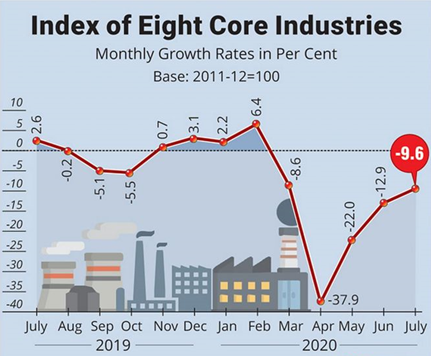Economy
Core Sector Contracted by 9.6%
- 01 Sep 2020
- 3 min read
Why in News
The output of eight core infrastructure sectors dropped by 9.6% in July 2020. It has been a continued contraction for the past five months.
Key Points
- Reasons: The contraction is due to a decline mostly in the production of steel, refinery products, and cement.
- In general, the weak demand and over-supply along with global and domestic disruptions due to Covid-19 are hampering the mobilization of economic resources.
- In July, local demand growth has slowed because of high fuel prices, renewed lockdown in parts of the country, and as monsoon rains hit transport, industrial and construction activity.
- Scenario:
- The production of eight core sectors had expanded by 2.6% in July 2019.
- Barring Fertiliser (grew by 6.9%), all seven sectors — coal, crude oil, natural gas, refinery products, steel, cement and electricity — recorded negative growth in July.
- The output of steel saw the highest decline (16.5%). It was followed by refinery products (13.9%).
- The minimum contraction in the output is in the electricity sector with 2.3%.
Core Sector Industries
- The eight core sector industries include coal, crude oil, natural gas, refinery products, fertiliser, steel, cement, and electricity.
- These comprise 40.27% of the weight of items included in the Index of Industrial Production (IIP).
- The eight core Industries in decreasing order of their weightage: Refinery Products> Electricity> Steel> Coal> Crude Oil> Natural Gas> Cement> Fertilizers.
| Industry | Weight (In percentage) |
| Petroleum & Refinery production | 28.04 |
| Electricity generation | 19.85 |
| Steel production | 17.92 |
| Coal production | 10.33 |
| Crude Oil production | 8.98 |
| Natural Gas production | 6.88 |
| Cement production | 5.37 |
| Fertilizers production | 2.63 |
Index of Industrial Production
- The Index of Industrial Production (IIP) is an indicator that measures the changes in the volume of production of industrial products during a given period.
- It is compiled and published monthly by the National Statistical Office (NSO), Ministry of Statistics and Programme Implementation.
- IIP is a composite indicator that measures the growth rate of industry groups classified under:
- Broad sectors, namely, Mining, Manufacturing, and Electricity.
- Use-based sectors, namely Basic Goods, Capital Goods, and Intermediate Goods.
- Base Year for IIP is 2011-2012.
- Significance of IIP:
- It is used by government agencies including the Ministry of Finance, the Reserve Bank of India, etc, for policy-making purposes.
- IIP remains extremely relevant for the calculation of the quarterly and advance GDP estimates.







